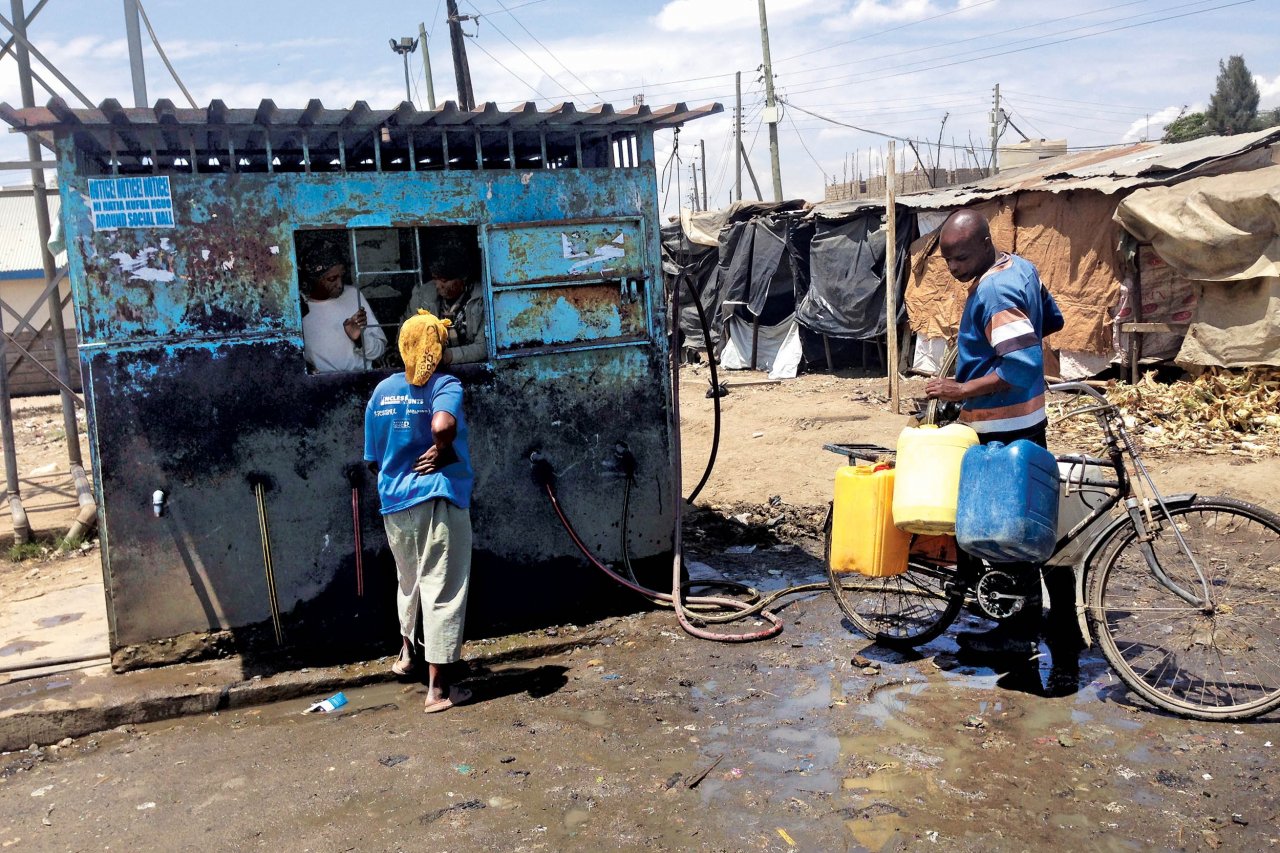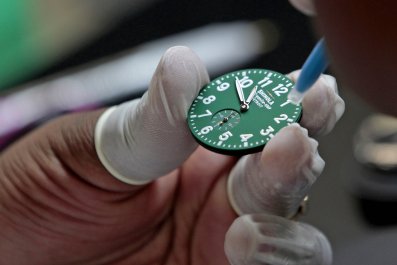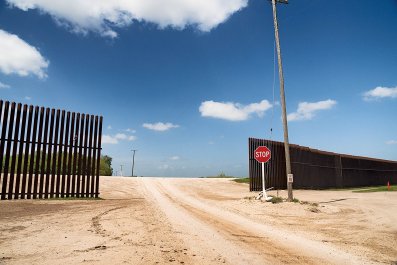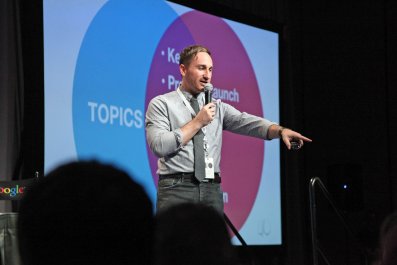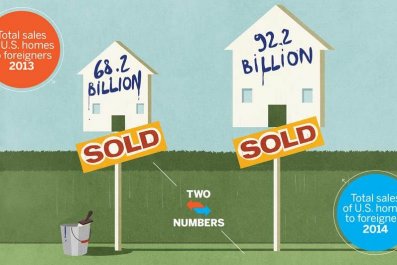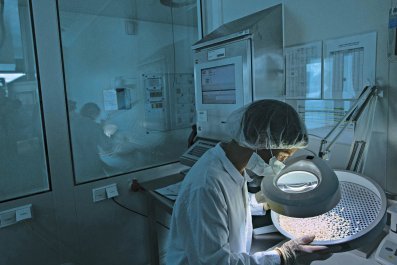At 8 a.m., Patrick Mwangi meets me for breakfast at the Serena Hotel in downtown Nairobi. We are in the hotel's restaurant, seated at a table covered in white linen, yards from an infinity pool that edges up to a row of jacaranda trees sheltering the well-manicured grounds from the stink and squalling of the city on the other side.
Mwangi, Nairobi-born and bred, is a World Bank water and sanitation specialist, and the driving force behind the Jisomee Mita water-development project, launched earlier this year in the city's Soweto Slums. "It's taken three years, and it's still a nightmare," he says as he heaps a gob of Danish butter on his rye bread and our waiter refills my glass out of a metal pitcher wrapped in white cloth.
After breakfast, Mwangi hands me off to a PR rep working for the Nairobi City Water & Sewerage Company (NCWSC), the city's primary water utility. We hop in a pickup stenciled with the NCWSC logo, and drive out of Nairobi's city center, with its bustling conference centers and international-brand hotels, to Soweto, about eight miles away. The slums are tiny, just barely one square mile—but has somewhere between 100,000 and 200,000 residents, making it four to eight times as dense as New York City. It was formed in the wake of government relocation programs in the 1980s and 1990s. Each resident was given a tiny plot for a new homestead, but the city didn't connect them to water, leaving families with the formidable challenge of filling their plastic yellow jerry cans (ubiquitous in Nairobi) every day.
In most parts of the U.S., no second thought is given to taking a Big Gulp plastic cup, filling it with water from the tap and chugging that down in a shot or two. Nor do the majority of Americans pause to consider that a five-minute shower fritters away 12.5 gallons of water—more than double what the World Health Organization says is the minimum amount needed for daily basic hygiene and food needs. But in Soweto—and throughout the developing world—no drop is taken for granted. Women and children wait on long lines at public water kiosks, which are, on paper, managed by employees or subcontractors working for the water utility, but are in practice usually guarded by some of the slum's most unsavory residents. Cartels of gangsters either take over the kiosks or tap the pipes in strategic locations, blocking the flow of water and then selling it at exorbitant rates—far more than the utility would charge.
And because the utility gets nothing for this water, it doesn't bother responding to complaints from residents when there is foul play, foul water or the tap runs dry, a crisis that can sometimes drag on for weeks in Soweto.
Those weeks (and the days when there is no money to pay the cartel) are the most precarious for the locals. Instead of taking their jerry cans to the hijacked public tap, the women and children have to go down to the disastrously polluted Ngong River, which reeks of garbage and feces. According to the United Nations Environment Programme, it is the most polluted river in Kenya; Nairobi's industrial area is upriver, and factories dump waste—petrochemicals, metals and more—into it. It also acts as Soweto's de facto sewage system. There are no sewer pipes in the slums; the outdoor toilets have metal basins at the bottom, and when those basins are full, they are dumped into the river. And poor people drink that sludge, because they need water to survive.
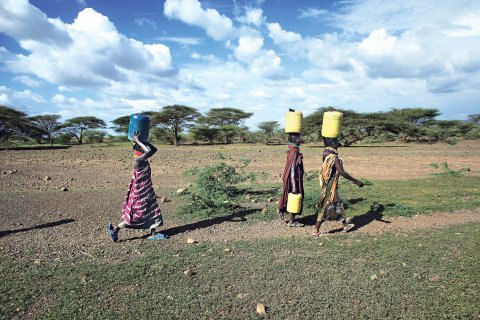
Waterborne diseases (like cholera, diarrhea, hepatitis A and typhoid) are rampant in the poor neighborhoods of Nairobi (and in similar locations around the world), particularly among young children: The World Health Organization says 3.4 million people die every year from water-related disease, making it the leading cause of disease-related death in the world.
In 2010, the Kenyan government ratified a new constitution that made access to water a universal right. The city's three water utility companies are now obliged to show they are taking steps toward ensuring that all city residents—even the poor slum dwellers—can access clean water. "[We] had to go back to the drawing board to figure out how can we serve these people," Vicky Mayo, an NCWSC employee, recently told Public Radio International. "We can no longer wish them away."
The Soweto project, developed with the input of the World Bank's Africa Region team, is meant to provide water security to the residents of the slum—to bring water taps into each and every home so that families would no longer have to buy overpriced water from the pipe-hijacking cartels or drink from the contaminated river. But despite the government mandate, and the potential financial gains that could come from reclaiming their pipes from the cartels, the NCWSC was nervous about committing the infrastructural investment needed to bring clean water to individual households. "Everyone told me that no poor people will pay," Mwangi says. After all, most Soweto residents do not even have mailboxes to which bills could be sent.
Mwangi's solution was Jisomee Mita ("Read Your Meter" in Swahili), a simple technological tool that makes it much easier for the people of Soweto to pay up. Here's how it works: Every in-home tap installed as part of the project has a meter on it. Project participants are told to read their meter whenever they want and text those readings to #2618. Within minutes, the bill is texted back. Then they can use M-Pesa—the mobile-phone based money transfer service that has become omnipresent throughout Kenya—to send a payment. The ability to pay whenever was a boon for the many Soweto residents who make their living in an informal sector that pays no mind to monthly billing cycles.
However, if they skip an entire month without paying, they will get hit with a small interest charge. That's because, to pay for the new pipe that brings water into the homes of the Jisomee Mita clients, the NCSWS had to take out a large loan—and pass the cost on to customers. That works out to about $1 tacked on to each bill.
This is where it all gets a bit sticky. Many water (and other resource) rights advocates find it abhorrent that the locals, the beneficiaries here, are essentially forced to take on a small loan in order to get water. The World Bank has been criticized extensively in recent years for indebting developing countries in precisely this manner. Peter Gleick, president of the Pacific Institute and a longtime climate and water scientist, has mixed feelings. "You do want people to pay for water—that's how systems become financially stable," he says. "But you also want to acknowledge the severe poverty, and you cannot deny people access the water. There is a human right to water."
The Soweto model might be "better than the terrible system that was there before," because people are being given more secure access to clean water says Meera Karunananthan, an international water campaigner for the nonprofit Council of Canadians, but it's still far from ideal. Karunananthan argues the project is a private endeavor hiding behind the veneer of the public utility. "The World Bank continues to press privatization despite its own evidence showing that privatization has failed communities around the world."
After a massive push to privatize water utilities in developing countries in the 1990s and early 2000s, the past decade has seen major pushback. Last year in Tanzania, for example, activists demanded their government not repay a $61.5 million World Bank loan for a water and sanitation project that was, according to the World Bank, "unable to meet many of its targets and obligations."
In Soweto, though, "we are not pushing anything on anybody," Mwangi insists. The system was designed with public participation and the local community in mind. Mwangi and others also point out that the World Bank's contributions to the project are gratis—the only string attached is that NCWSC has to prove its delivery and payment systems work before it can get the money.
Others argue that the Jisomee Mita system is working so well precisely because it requires a financial commitment. The utility used to ignore the complaints coming from low-income areas, which were seen as charity cases. But now, response rates are way up, Mwangi says, because the project has turned the poor into paying customers, with a voice that demands a response. NCWSC has responded by launching a new reporting tool called Magi Voice (Magi means "water" in Swahili) to facilitate customer complaints, and the utility says it has resolved 70 percent of the concerns.
And in fact, the bills are getting paid. The utility says they are currently collecting about nearly double the monthly usage fees from Soweto since Jisomee Mita was implemented.
Gleick, has a theory on why. To date, he says "people haven't been asked to pay for water services, and the services they been provided with have rarely been worth paying for." But, "if people have confidence in the services they are getting and if those services are valuable to them, they will pay for it."
Getting water delivered straight to your home seems like such a prosaic thing, but for Soweto residents it has been life-changing. The children are staying in school—instead of spending their early mornings and evenings tracking down drinkable water, they can do their homework and get to school on time. Instead of waiting in line for overpriced, cartel-guarded water, women have begun to open up shops, or find other work. Households are bringing in greater income and spending less. Police chief Job Kivundui told local newspaper The Star that in recent months the number rapes reported to the nearest police station have gone down to near zero. "Domestic rape cases that reportedly took place in the wee hours of the morning as women leave early to look for water has since dropped," he said. Landowners are tearing down their old tin and mud huts and building more structurally sound brick and concrete buildings—even some middle-class, gated developments have recently sprung up on the outskirts of the slum.
Most important, the people are healthier. It was easy enough to find a Jisomee Mita participant in Soweto. I just knocked on doors until I found someone who was home. Mutua Kittokoi owns a small building—a bare-bones affair with a shared latrine, where each dirt-floored, tin-walled room rents for about $12 a month. Previously, Kittokoi was getting water (both for himself and his tenants) from a nearby borehole. "We had a lot of diseases before," Kittokoi tells me through a translator, "malaria, diarrhea, etc., etc." Now, his tap runs clean, reliably, and there is no disease.
The Jisomee Mita project is still in the red—Mwangi estimates that it will take five years for the entire loan to be repaid. But demand to participate in the project is growing. There are about 2,000 connections now in Soweto, and 16,000 planned for other parts of Nairobi. In Soweto, the locals are excited that the program will be expanded to include sewage services. And that might save the Ngong: If the slum continues to improve economically and ecologically, perhaps a waste-free Ngong could become host to a new wave of riverside development, with homes, restaurants, shops and bars to serve Soweto's newly risen middle class.
November 17, 2014: This article originally misspelled the last name of Patrick Mwangi and the first name of Mutua Kittokoi.



